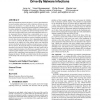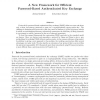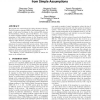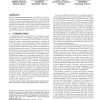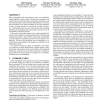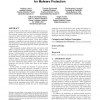CCS
2010
ACM
13 years 4 months ago
2010
ACM
Web-based surreptitious malware infections (i.e., drive-by downloads) have become the primary method used to deliver malicious software onto computers across the Internet. To addr...
CCS
2010
ACM
13 years 4 months ago
2010
ACM
Protocols for password-based authenticated key exchange (PAKE) allow two users who share only a short, low-entropy password to agree on a cryptographically strong session key. The...
CCS
2010
ACM
13 years 4 months ago
2010
ACM
Decentralized information flow control (DIFC) operating systems provide applications with mechanisms for enforcing information-flow policies for their data. However, significant o...
CCS
2010
ACM
13 years 4 months ago
2010
ACM
Cross-origin CSS attacks use style sheet import to steal confidential information from a victim website, hijacking a user's existing authenticated session; existing XSS defen...
CCS
2010
ACM
13 years 4 months ago
2010
ACM
Congestion control algorithms seek to optimally utilize network resources by allocating a certain rate for each user. However, malicious clients can disregard the congestion contr...
CCS
2010
ACM
13 years 4 months ago
2010
ACM
We provide new constructions of Leakage-Resilient IdentityBased Encryption systems (IBE) in the Standard model. We apply a hash proof technique in the existing IBE schemes of Bone...
CCS
2010
ACM
13 years 4 months ago
2010
ACM
Computational Indistinguishability Logic (CIL) is a logic for reasoning about cryptographic primitives in computational models. It captures reasoning patterns that are common in p...
CCS
2010
ACM
13 years 4 months ago
2010
ACM
Many cryptographic tasks and protocols, such as non-repudiation, contract-signing, voting, auction, identity-based encryption, and certain forms of secure multi-party computation,...
CCS
2010
ACM
13 years 4 months ago
2010
ACM
Heap-based attacks depend on a combination of memory management errors and an exploitable memory allocator. We analyze a range of widely-deployed memory allocators, including thos...
CCS
2010
ACM
13 years 4 months ago
2010
ACM
Models based on system calls are a popular and common approach to characterize the run-time behavior of programs. For example, system calls are used by intrusion detection systems...
